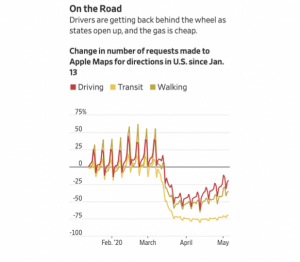The EPA will propose new biofuel blending requirements for oil refiners for the coming two years that will likely include a lower biomass-based diesel mandate than industry groups had requested,…
As Americans Get Back Behind the Wheel, Better News for Ethanol
Also last week, Wall Street Journal writer Rebecca Elliott reported that, “Americans are starting to get back behind the wheel, welcome news for the companies that turn oil into gasoline and diesel.

“Fuel makers including Valero Energy Corp. and Phillips 66 have said they expect gasoline demand to continue to rebound after plunging to roughly half of normal levels in early April, as states reopen from lockdowns imposed to limit the spread of the new coronavirus.
As a result, some refiners are looking to produce more gasoline again after choking back output in recent weeks.
The Journal article added that, “‘People have been cooped up, they want to drive,’ Phillips 66 Chief Executive Greg Garland told investors recently, offering a glimmer of hope as the largest U.S. refiners posted their worst quarterly earnings in years.”
I can’t stress enough how disappointed I am that biofuels were denied aid from @USDA — but I'm proud to join Sec. Vilsack and Lt. Gov. Judge in the fight to support our growers & producers. I’ll demand assistance in any new COVID-19 aid package. #IA01 https://t.co/XQhVEYOp0H
— Abby Finkenauer (@RepFinkenauer) May 3, 2020
And John Kemp noted in a Reuters column last week that, “U.S. gasoline consumption has started to increase in a sign motorists are starting to use their cars more as the economic lockdown eases.”
Mr. Kemp explained that, “Fuel consumption data show an economy that had adjusted to an exceptional economic shock by the middle of April and demonstrated some signs of improving in the second half of the month.
National Weekly Ag Energy Round-Up; Friday, May 8th https://t.co/nn7VIRBP6a @USDA_AMS
— Farm Policy (@FarmPolicy) May 9, 2020
* #Iowa #ethanol prices.
* 2020, 2019 and five-year average. pic.twitter.com/ax0v3P5g5R
“The volume of gasoline supplied to the domestic market rose to almost 6.7 million barrels per day (bpd) last week, according to estimates prepared by the U.S. Energy Information Administration.
“Gasoline supplied has increased for four weeks running, a sign the coronavirus-driven lockdown on personal mobility is starting to ease.”
Meanwhile, DTN writer Todd Neeley reported last week that, “One day after a bipartisan group of 24 United States senators pressed the Trump administration to deny the request of five governors to waive the Renewable Fuel Standard, the Governors’ Biofuels Coalition has done the same.
“In a letter to EPA Administrator Andrew Wheeler on Friday, the coalition said granting a waiver to the states of Louisiana, Texas, Utah, Oklahoma and Wyoming, would inflict further damage to the agriculture and rural America.”
The #RFS is more important than ever as farmers, the biofuel sector, & rural America struggle amid #COVID19. Waiving it would cause further harm to our economy.
— Joni Ernst (@SenJoniErnst) May 7, 2020
I led a bipartisan letter urging @POTUS to uphold the #RFS & to reject requests for it to be waived. pic.twitter.com/dMgRMKAfwR
The DTN article indicated that, “The ethanol and oil industries have suffered a double economic whammy — falling oil prices from a Russia/Saudi Arabia oil war and dropping gasoline demand from the COVID-19 shutdown.”





